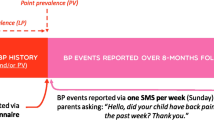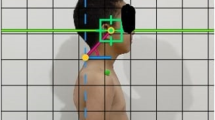Abstract
The possible effects of back education on children’s back function were never evaluated. Therefore, main aim of the present study was to evaluate the effects of back education in elementary schoolchildren on back function parameters. Since the reliability of back function measurement in children is poorly defined, another objective was to test the selected instruments for reliability in 8–11-year olds. The multi-factorial intervention lasting two school-years consisted of a back education program and the stimulation of postural dynamism in the class. Trunk muscle endurance, leg muscle capacity and spinal curvature were evaluated in a pre-post design including 41 children who received the back education program (mean age at post-test: 11.2 ± 0.9 years) and 28 controls (mean age at post-test: 11.4 ± 0.6 years). Besides, test–retest reliability with a 1-week interval was investigated in a separate sample. Therefore, 47 children (mean age: 10.1 ± 0.5 years) were tested for reliability of trunk muscle endurance and 40 children (mean age: 10.2 ± 0.7 years) for the assessment of spinal curvatures. Reliability of endurance testing was very good to good for the trunk flexors (ICC = 0.82) and trunk extensors (ICC = 0.63). The assessment of the thoracic (ICC = 0.69) and the lumbar curvature (ICC = 0.52) in seating position showed good to acceptable reliability. Low ICCs were found for the assessment of the thoracic (ICC = 0.39) and the lumbar curvature (ICC = 0.37) in stance. The effects of 2 year back education showed an increase in trunk flexor endurance in the intervention group compared to a decrease in the controls and a trend towards significance for a higher increase in trunk extensor endurance in the intervention group. For leg muscle capacity and spinal curvature no intervention effects were found. The small samples recommend cautious interpretation of intervention effects. However, the present study’s findings favor the implementation of back education with focus on postural dynamism in the class as an integral part of the elementary school curriculum in the scope of optimizing spinal loading through the school environment.


Similar content being viewed by others
References
Adams MA, Mannion AF, Dolan P (1999) Personal risk factors for first-time low back pain. Spine 24:2497–2505
Alaranta H, Hurri H, Heliovaara M, Soukka A, Harju R (1994) Non-dynamometric trunk performance tests—reliability and normative data. Scand J Rehabil Med 26:211–215
Balagué F, Damidot P, Nordin M, Parnianpour M, Waldburger M (1993) Cross-sectional study of the isokinetic muscle trunk strength among school-children. Spine 18:1199–1205
Balagué F, Troussier B, Salminen JJ (1999) Non-specific low back pain in children and adolescents: risk-factors. Eur Spine J 8:429–438
Biering-Sörensen F (1984) Physical measurement as risk indicators for low back trouble over a one-year period. Spine 9:143–148
Cardon G, Balagué F (2004) Low back pain prevention’s effects in schoolchildren. What is the evidence? Eur Spine J 13:663–679
Cardon G, De clercq D, De Bourdeaudhuij I, Breithecker D (2004) Sitting habits in elementary schoolchildren: a traditional versus a ‘Moving school’. Patient Educ Couns 54:133–142
Cardon GM, de Clercq DL, Geldhof EJ, Verstraete S, de Bourdeaudhuij IM (2006) Back education in elementary schoolchildren: the effects of adding a physical activity promotion program to a back care program.Eur Spine J. Epub ahead of print
Coorevits P, Danneels L, Ramon H, Van Audekercke R, Cambier D, Vanderstraeten G (2005) Statistical modelling of fatigue-related electromyographic median frequency characteristics of back and hip muscles during a standardized isometric back extension test. J Electromyogr Kines 15:444–451
Deighan M, Croix M, Armstrong N (2003) Reliability of isokinetic concentric and eccentric knee and elbow extension and flexion in 9/10 year old boys. Isokinet Exerc Sc 11:109–115
Drouin JM, Valovich-mcLeod TC, Shultz SJ, Gansneder BM, Perrin DH (2004) Reliability and validity of the Biodex system 3 pro isokinetic dynamometer velocity, torque and position measurements. Eur J Appl Physiol 91:22–29
Elftman H (1966) Biomechanics of muscle with particular application to studies of gait. J Bone Joint Surg Am 48:363–377
Escamilla RF, Fleisig GS, Lowry TM, Barrentine SW, Andrews JR (2001) A three-dimensional biomechanical analysis of the squat during varying stance widths. Med Sci Sport Exer 33:984–998
Essendorp M, Schibye B, Hey-Knudsen C (2002) Intra-abdominal pressure increases during exhausting back extension in humans. Eur J Appl Physiol 87:167–173
Feldman DE, Shrier I, Rossignol M, Abenhaim L (2001) Risk factors for the development of low back pain in adolescence. Am J Epidemiol 154:30–36
Geldhof E, Cardon G, De Bourdeaudhuij I, De Clercq D (2006) Effects of a two-school-year multi-factorial back education program in elementary schoolchildren. Spine 31(17):1965–1973
Harreby M, Neergaard K, Hesseloe G (1995) Are radiologic changes in the thoracic and lumbar spine of adolescents risk factors for low back pain in adults? Spine 20:2298–2302
Harrison DD, Harrison SO, Croft AC, Harrison DE, Troyanovich SJ (1999) Sitting biomechanics part I: review of the literature. J Manipulative Physiol Ther 22:594–609
Heather C, Shrawan K, Sharon W (1995) Postural aberrations in low back pain. Arch Phys Med Rehab 76:218–224
Ho CW, Chen LC, Hsu HH, Chiang SL, Li MH, Jiang SH, Tsai KC (2005) Isokinetic muscle strength of the trunk and bilateral knees in young subjects with lumbar disc herniation. Spine 30:528–533
Hyytiainen K, Salminen JJ, Suvitie T, Wickstrom G, Pentti J (1991) Reproducibility of 9 tests to measure spinal mobility and trunk muscle strength. Scand J Rehabil Med 23:3–10
Jones GT, Watson KD, Silman AJ, Symmons DP, Macfarlane GJ (2003) Predictors of low back pain in British schoolchildren: a population-based prospective cohort study. Pediatrics 111:822–828
Jones MA, Stratton G, Reilly T, Unnithan VB (2005) Biological risk indicators for recurrent non-specific low back pain in adolescents. Br J Sports Med 39:137–140
Kristjansdottir G, Rhee H (2002) Risk factors of back pain frequency in schoolchildren: a search for explanations to a public health problem. Acta Paediatr 91:849–854
Latimer J, Maher CG, Refshauge K, Colaco I (1999) The reliability and validity of the Biering-Sorensen test in asymptomatic subjects and subjects reporting current or previous nonspecific low back pain. Spine 24:2085–2089
Lee JH, Ooi Y, Nakamura K (1995) Measurement of muscle strength of the trunk and the lower extremities in subjects with history of low back pain. Spine 20:1994–1996
Lee JH, Hoshino Y, Nakamura K, Kariya Y, Saita K, Ito K (1999) Trunk muscle weakness as a risk factor for low back pain—a 5-year prospective study. Spine 24:54–57
Malmstrom EM, Karlberg M, Melander A, Magnusson M (2003) Zebris versus Myrin: a comparative study between a three-dimensional ultrasound movement analysis and an inclinometer/compass method: intradevice reliability, concurrent validity, intertester comparison, intratester reliability, and intraindividual variability. Spine 28:433–440
Mannion AF, Klein GN, Dvorak J, Lanz C (2000) Range of global motion of the cervical spine: intraindividual reliability and the influence of measurement device. Eur Spine J 9:379–385
McGill SM, Childs A, Liebenson C (1999) Endurance times for low back stabilization exercises: clinical targets for testing and training from a normal database. Arch Phys Med Rehab 80:941–944
McIntosh G, Wilson, Affleck M, Hall H (1998) Trunk and lower extremity muscle endurance: normative data for adults. J Rehabil Outcomes Meas 2:20–39
Newcomer K, Sinaki M (1996) Low back pain and its relationship to back strength and physical activity in children. Acta Paediatr 85:1433–1439
Newcomer K, Sinaki M, Wollan PC (1997) Physical activity and four-year development of back strength in children. Am J Phys Med Rehabil 76:52–58
Nordin M, Kahanovitz N, Verderame R, Parnianpour M, Yabut S, Viola K, Viola K, Greenidge N, Mulvihill M (1987) Normal trunk muscle strength and endurance in women and the effect of exercises and electrical-stimulation. Part 1: Normal endurance and trunk muscle strength in 101 women. Spine 12:105–111
Oksanen A, Salminen JJ (1996) Tests of spinal mobility and muscle strength in the young: reliability and normative values. Physiother Theory Pract 12:151–160
O’Sullivan PB, Grahamslaw KM, Kendell MM, Lapenskis SC, Möller NE, Richards KV (2001) The effect of different standing and sitting postures on trunk muscle activity in a pain free population. In: Proceedings of the interdisciplinary World congress on low back and pelvic pain, Montreal, pp 180–183
Poussa MS, Heliovaara MM, Seitsamo JT, Kononen MH, Hurmerinta KA, Nissinen MJ (2005) Predictors of neck pain: a cohort study of children followed up from the age of 11 to 22 years. Eur Spine J 14:1033–1036
Salminen JJ, Maki P, Oksanen A, Pentti J (1992) Spinal mobility and trunk muscle strength in 15-year-old schoolchildren with and without low-back-pain. Spine 17:405–411
Salminen JJ, Erkintalo M, Laine M, Pentti J (1995) Low-back-pain in the young—a prospective 3-year follow-up-study of subjects with and without low-back-pain. Spine 20:2101–2107
Salminen JJ, Erkintalo M, Pentti J, Oksanen A, Kormano M (1999) Recurrent low back pain and early disc degeneration in the young. Spine 24:1316–1321
Sjölie AN, Ljunggren AE (2001) The significance of high lumbar mobility and low lumbar strength for current and future low back pain in adolescents. Spine 26:2629–2636
Strimpakos N, Sakellari V, Gioftsos G, Papathanasiou M, Brountzos E, Kelekis D, Kapreli E, Oldham J (2005) Cervical spine ROM measurements: optimizing the testing protocol by using a 3D ultrasound-based motion analysis system. Cephalalgia 25:1133–1145
Suter E, Lindsay D (2001) Back muscle fatigability is associated with knee extensor inhibition in subjects with low back pain. Spine 26:361–366
Udermann BE, Mayer JM, Graves JE, Murray SR (2003) Quantitative assessment of lumbar paraspinal muscle endurance. J Athl Train 38:259–262
van Dieen JH, Hoozemans MJM, Toussaint HM (1999) Stoop or squat: a review of biomechanical studies on lifting technique. Clin Biomech 14:685–696
Verstraete SJ, De Bourdeaudhuij IM, Cardon GM (2003) Validation of a physical activity questionnaire for children. In: Proceedings of the American College of Sports Medicine. Med Sci Sport Exer 35(5):64
Wang SF, Teng CC, Lin KH (2005) Measurement of cervical range of motion pattern during cyclic neck movement by an ultrasound-based motion system. Man Ther 10:68–72
Watson KD, Papageorgiou AC, Jones GT Taylor S, Symmons DP, Silman AJ, Macfarlane GJ (2002) Low back pain in schoolchildren: occurrence and characteristics. Pain 97:87–92
Widhe T (2001) Spine: posture, mobility and pain—a longitudinal study from childhood to adolescence. Eur Spine J 10:118–123
Acknowledgments
This study is part of a broader research project entitled: Sport, Physical Activity and Health (Sport, Beweging en Gezondheid), carried out by a consortium of researchers from KULeuven, Ghent University and VUBrussels, funded by the Flemish Government.
Author information
Authors and Affiliations
Corresponding author
Rights and permissions
About this article
Cite this article
Geldhof, E., Cardon, G., De Bourdeaudhuij, I. et al. Effects of back posture education on elementary schoolchildren’s back function. Eur Spine J 16, 829–839 (2007). https://doi.org/10.1007/s00586-006-0199-4
Received:
Revised:
Accepted:
Published:
Issue Date:
DOI: https://doi.org/10.1007/s00586-006-0199-4




